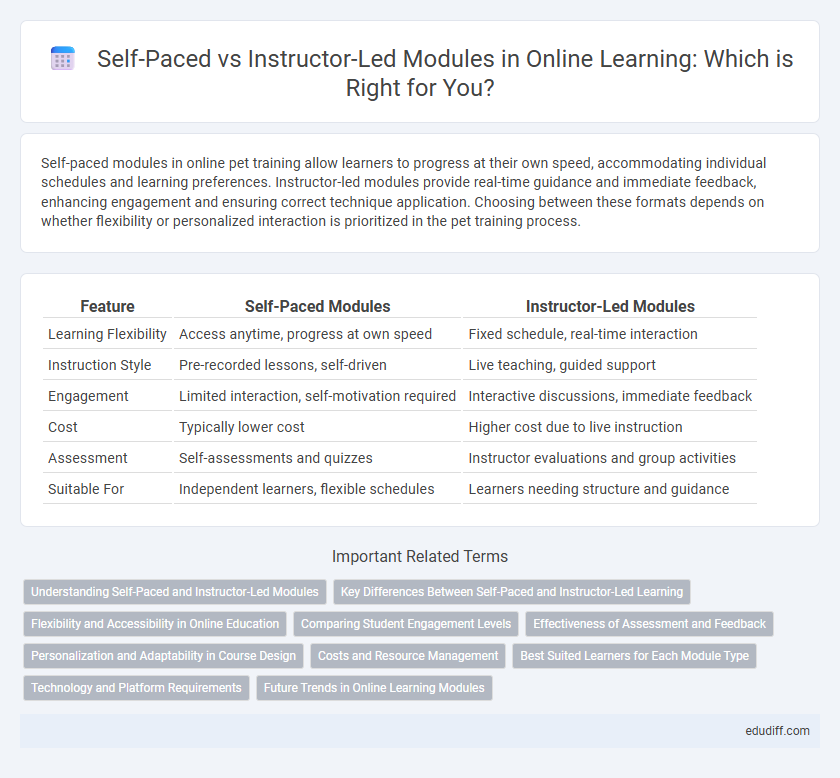Self-paced modules in online pet training allow learners to progress at their own speed, accommodating individual schedules and learning preferences. Instructor-led modules provide real-time guidance and immediate feedback, enhancing engagement and ensuring correct technique application. Choosing between these formats depends on whether flexibility or personalized interaction is prioritized in the pet training process.
Table of Comparison
| Feature | Self-Paced Modules | Instructor-Led Modules |
|---|---|---|
| Learning Flexibility | Access anytime, progress at own speed | Fixed schedule, real-time interaction |
| Instruction Style | Pre-recorded lessons, self-driven | Live teaching, guided support |
| Engagement | Limited interaction, self-motivation required | Interactive discussions, immediate feedback |
| Cost | Typically lower cost | Higher cost due to live instruction |
| Assessment | Self-assessments and quizzes | Instructor evaluations and group activities |
| Suitable For | Independent learners, flexible schedules | Learners needing structure and guidance |
Understanding Self-Paced and Instructor-Led Modules
Self-paced modules offer learners flexibility to progress at their own speed, accommodating diverse schedules and personalized learning paces, while instructor-led modules provide structured, real-time engagement with experts facilitating immediate feedback and collaboration. The effectiveness of self-paced learning relies heavily on learner motivation and discipline, whereas instructor-led sessions enhance accountability and dynamic interaction. Understanding these key differences helps organizations tailor training programs aligning with specific learning objectives and workforce needs.
Key Differences Between Self-Paced and Instructor-Led Learning
Self-paced modules offer flexible scheduling and personalized learning speeds, allowing learners to progress independently without real-time interaction with instructors. Instructor-led modules provide structured timelines, direct guidance, and immediate feedback through live sessions, enhancing learner engagement and accountability. Key differences include autonomy in content delivery, pacing control, and the level of instructor support, which significantly impact learner motivation and retention.
Flexibility and Accessibility in Online Education
Self-paced modules offer unparalleled flexibility, allowing learners to access content anytime and progress according to their own schedule, which is ideal for balancing education with personal and professional commitments. Instructor-led modules provide structured guidance and real-time interaction, enhancing engagement but requiring fixed schedules that may limit accessibility for some students. The choice between the two depends on individual learning preferences and the need for either autonomous study or collaborative support.
Comparing Student Engagement Levels
Self-paced modules offer flexible learning schedules, allowing students to progress at their own pace, which can enhance motivation for independent learners but may decrease overall engagement without real-time interaction. Instructor-led modules provide structured timelines and live interaction with educators, fostering immediate feedback and peer collaboration that typically result in higher engagement levels. Studies show that combining both approaches, through blended learning, optimizes student engagement by balancing autonomy with guided support.
Effectiveness of Assessment and Feedback
Self-paced modules offer flexible assessment opportunities, enabling learners to revisit content and receive immediate automated feedback, which supports individualized learning pace and retention. Instructor-led modules provide dynamic, personalized feedback through real-time evaluations and interactive discussions, fostering deeper learner engagement and more nuanced understanding. Both approaches improve effectiveness by aligning feedback methods with specific learning objectives and assessment types.
Personalization and Adaptability in Course Design
Self-paced modules offer high personalization by allowing learners to control the pace, revisit content, and tailor study schedules to individual needs, enhancing adaptability for diverse learning styles. Instructor-led modules provide adaptive feedback and real-time interaction, enabling immediate adjustment of course material based on learner responses, which caters to dynamic learning environments. Combining self-paced flexibility with instructor-led customization elevates course design by addressing varied learner preferences and optimizing engagement.
Costs and Resource Management
Self-paced modules significantly reduce costs by eliminating the need for live instructor fees and allowing learners to access materials anytime, optimizing resource allocation. Instructor-led modules require scheduling, dedicated instructor time, and often higher operational expenses due to real-time engagement and facilitation. Organizations benefit from self-paced modules when aiming for scalable, cost-efficient training solutions while instructor-led modules provide targeted guidance that may justify higher investment based on learner needs.
Best Suited Learners for Each Module Type
Self-paced modules best suit independent learners who prefer controlling their study schedule and pace, often benefiting professionals balancing work and education. Instructor-led modules cater to learners seeking structured guidance, real-time interaction, and collaborative environments, such as students needing direct feedback or team-based skill development. Understanding learner preferences and goals ensures optimal engagement and mastery in online education.
Technology and Platform Requirements
Self-paced modules demand robust Learning Management Systems (LMS) with features like progress tracking, multimedia support, and mobile compatibility to ensure seamless user experience. Instructor-led modules require stable video conferencing platforms with real-time interaction capabilities, integrated scheduling tools, and reliable bandwidth to facilitate live engagement. Both formats benefit from cloud-based infrastructure to provide scalable access and support asynchronous content delivery alongside synchronous sessions.
Future Trends in Online Learning Modules
Self-paced modules leverage AI-driven adaptive learning technologies, enabling personalized content delivery that adjusts to individual learner progress and preferences. Instructor-led modules are evolving to incorporate augmented reality (AR) and virtual reality (VR), enhancing real-time interaction and immersive experiences. Future trends emphasize hybrid models combining asynchronous self-paced flexibility with synchronous instructor engagement to maximize learner outcomes.
Self-paced modules vs Instructor-led modules Infographic

 edudiff.com
edudiff.com